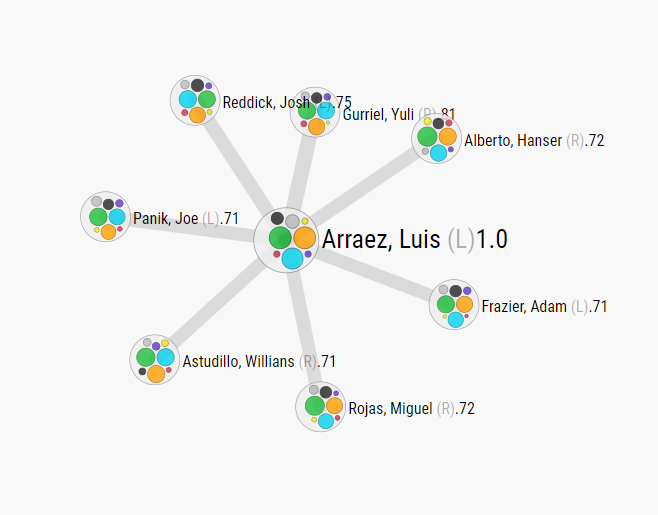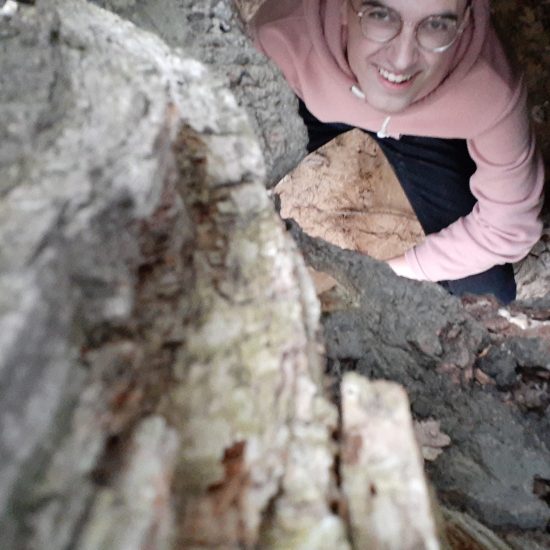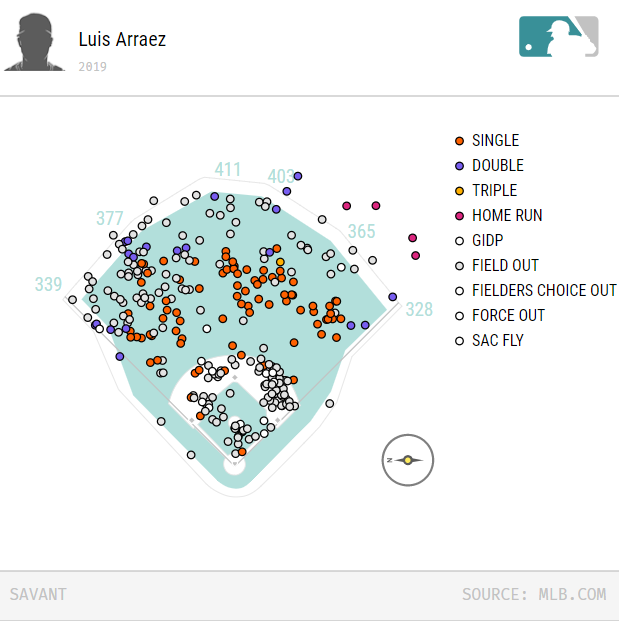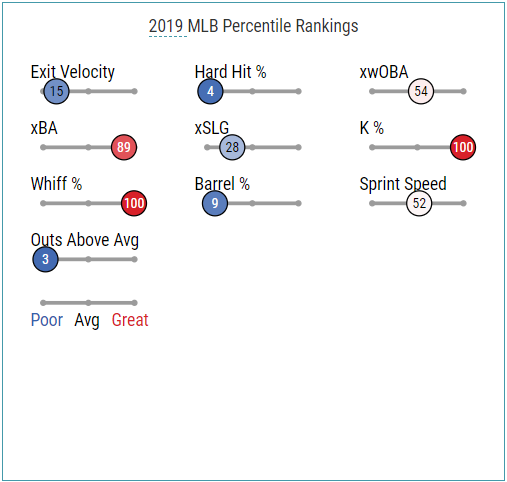Three years ago, Luis Arraez was virtually unknown within the United States. Prospect evaluators had him outside of the Twins top-20 prospects, and most fans had never heard of him. Stateside, he didn’t have many followers.
In Venezuela, however, Arraez developed a cult following. Even at eight years younger than the average Venezuelan Winter League player, Arraez hit .335, spraying hits all over the field. Fans loved it, and when Arraez came back to the United States for the 2017 season, he came back with a nickname. Luis Arraez had become La Regedara, The Sprinkler.
Arraez’s nickname is one of the funniest monikers in baseball, but also fits perfectly with his playing style. Arraez is heavily a spray hitter, with his batted ball events almost evenly split between left, center, and right fields. There is a slight disparity in quality depending on what part of the field he hits the ball toward, as when he pulls the ball he has a slightly higher tendency towards grounding out, but overall, Arraez is shift proof.
Arraez’s wonderful nickname and spray hitting tendencies aren’t what makes him a unique fantasy hitter, however. After all, plenty of players are spray hitters. What makes Arraez unique is that he is a player of extremes, and players of extremes are fun. Take a look at Arraez’s Statcast numbers from 2019.
What we see there is a lot of bright blue weakness, a few bright red areas where Arraez is elite, and not much of the faint grey coloring signifying mediocrity.
All three of those metrics marked in red reflect Arraez’s contact and plate approach. No player in baseball whiffed less often than Arraez, who only swang and missed 7.9% of the time in 2019. For context, David Fletcher was second in the league in whiff percentage last year and still swung and missed 9.8% of the time, nearly two percent more often than Arraez. Arraez did only play for half the year, but with over 1,500 pitches seen, that’s a large enough sample to comfortably realize that Arraez is a true outlier in avoiding swings and misses.
Because Arraez so rarely swings and misses, strikeouts are extremely rare. Just like his outlier numbers as far as whiff rate, Arraez is an outlier when it comes to avoiding strikeouts. Last year Andrelton Simmons struck out 8.7% of the time and had the second best rate in the majors. Arraez struck out at only a 7.9% clip.
Arraez isn’t simply the second base version of Willians Astudillo, a player who never strikes out because he swings at everything and can make contact. On the contrary, Arraez has an excellent plate approach for a young player. Arraez garnered a base on balls 9.8% of the time last year, a rate similar to players like Jose Ramirez and Max Kepler. That wouldn’t have been a league-leading pace, but it would have placed just inside the top 50 out of 135 qualified batters.
His profile isn’t all sunshine and rainbows, however. For all the excitement that those plate approach and contact metrics can provide, there were other areas in which Arraez struggled during his rookie campaign.
The metrics colored in blue show that Arraez lagged behind in exit velocity, outs above average, hard-hit rate, xSLG, and barrel rate. The poor outs above average number aren’t particularly concerning — he logged only about half a season last year and defensive metrics are notoriously unstable. Arraez doesn’t look great at second, but the eye test shows us that he’s not one of the fifteen worst defenders in baseball either.
The other blue numbers in that chart all correlate with one another. Each of those metrics calculates the same facet of a player’s game, as they focus on power. A player who has a poor average exit velocity will very rarely have even an average hard-hit percentage. This is because for a batted ball even to qualify as hard-hit, it has to be struck at 95 MPH or greater. For a player like Arraez who averaged only an 87 MPH exit velocity, that’s quite a leap from his average batted ball. xSLG is correlated in much the same way. Truth be told, Arraez struggled to hit the ball hard last year.
There are a few reasons why that could be the case. Arraez has a relatively unique body type, trending towards short and stocky, and tends to generate power from his hands and wrists, not his whole body. Watch this clip of a single Arraez hit earlier this week — he holds his head completely still, has only the smallest of leg kicks, and doesn’t move much outside of his arms in general.
https://gfycat.com/betteractualgadwall
Arraez’s body control and stillness is part of the reason why he strikes out so rarely. He can track the pitch well and react to the pitch later than most batters. By design, however, that saps his power. While many hitters load up to try and punish a ball, Arraez doesn’t do much of that. This approach limits his max power quite a bit. His peak exit velocity was only 102.2 MPH, 279th in baseball. Fortunately, while Arraez lacks extreme power, he’s consistent at hitting the ball moderately hard.
Note that while Arraez has very few batted ball events at over 100 MPH, the majority of his batted ball events overall were over 90 MPH. Because Arraez struggles to hit the ball hard, he’ll naturally have relatively few barrels, the final metric covered in blue on that chart we looked at earlier. A barrel is defined as a ball hit at at least 98 MPH and between 26 and 30 degrees. While he’ll rarely do that, he does generate a lot of the batted ball types that are next best: flares and burners.
Notice how most of Arraez’s batted ball events are grouped together. He hits very few hard enough to be placed in the bright red bucket that makes up barrels, but many are at the right launch angle, hit decently hard, and end up as a flare or burner. Jake Mailhot of FanGraphs wrote an article last August that looked into Arraez’s batted ball profile and questioned its sustainability. Since then, Arraez has more than doubled his plate appearances and kept up the results from his unique approach.
Because Arraez has such a unique batted ball profile, he’s able to sustain a remarkably high BABIP. In 2019, he hit .355 on balls in play, a mark that would seem ripe for regression, especially once Arraez’ middling speed is factored in. However, if we consider his minor league data, that number appears as though it could be sustainable. Only twice in eight stops has Arraez had a BABIP under .350, and in his largest sample, at A-ball in 2016, Arraez had a BABIP of .382 in 514 PA. Some of that could be poor defending at a lower level, but he’s more than shown he can maintain similar rates.
Overall, these extremes mean that Arraez can be relatively safely when it comes to projecting him. He whiffed less than anyone else last year and is keeping that pace up this year. He’s not likely to regress in that department, because of his unique approach and his track record of whiff free play in the minors. But at the same time, he has nearly no room for growth there. The same is true about his strikeout numbers — his plate approach and contact-heavy swing mean he’s not likely to regress significantly there but, again, there’s little room for growth.
Arraez’s approach also limits his power upside. His body mechanics during his swing mean he will never be an extreme power hitter. So what could Arraez become? While player similarity scores are often unhelpful, for unique players full of extremes, they can be helpful in showing a player’s potential upside or downside. 
At first glance, these similarity scores make a lot of sense. There are a lot of players with good plate discipline who don’t strike out often. This also shows Arraez’s upside and downside nicely. Prime Joe Panik is probably one of Arraez’s worst-case scenarios where he hits slightly over .300 with little power and few strikeouts. On the other hand, Yuli Gurriel, Arraez’s top comparison, offers some intriguing power upside. Like Arraez, Gurriel struggles to barrel the ball and produces low-end exit velocity numbers. Yet, Gurriel hit 31 home runs last year. If Arraez increases his exit velocity by a couple of ticks, then he could match Gurriel’s production. With Arraez’s consistency hitting the ball and the happy fun ball that’s been used in recent years, there’s a chance that Arraez could increase his power. Arraez will likely never hit 30 in a season, but there’s also a good chance that he’ll hit more than the 12 that Panik topped out at.
Overall, Arraez has the kind of profile that plays better in real life than fantasy. Fantasy leagues tend to reward power or speed, whereas Arraez’s game focuses on average. Arraez will rack up a lot of runs playing every day in an excellent Twins lineup, and his batting average could help offset a batting average drain on your team.
Arraez is useful in specific situations, and can safely be considered useful in those spots, but will never become a fantasy stud. He will, however, remain La Regedara.
Photo by Nick Wosika/Icon Sportswire | Adapted by Justin Paradis (@freshmeatcomm on Twitter)





Thanks for the analysis. OBP + R + multi-position eligibility = great 10th man in a daily H2H league. Viva La Regadera!